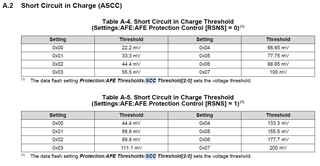Other Parts Discussed in Thread: BQSTUDIO, BQ40Z50
Tool/software:
Hi,
I'm preparing to perform a learning cycle and one of the recommendations is to set an appropriate ASCC - Short Circuit During Charge Threshold value.
Upon accessing the Data Memory - Protection menu in BQStudio the threshold value that can be set is in hex units and is currently set at 45. I'm honestly not sure where this value originally came from. Perhaps its a default value.

My interpretation is that based on Table A-4 there is a voltage value that corresponds to a hex value and that the current value at which the trip will occur is defined by the following equation:
Current = SCC Threshold / Rsense

Therefore for hex setting 0x00 which has a corresponding voltage value of 22.2 mV we have the following correlation
Trip Current = 22.2 mV / 0.001 R = 22.2 Amps where 0.001 is the resistance of Rsense in the BQ40Z50 BMS.
This seems very high.
Is this understanding of how to set the trip current based on the hex value and Table A.4 correct?
How do I input 0x00 into the Protection - ASCC - Threshold table? For 0x00 do I type in 0x00? Or just 00?
What is also confusing to me is that you can also set OCC1 and OCC2 in the Data Memory - Protections table which are the Overcurrent in Charge 1 and Overcurrent in Charge 2 and have mA values that can be inputted. This is much more clear to in terms of setting a current value at which a trip will occur.
Which method is the correct method for setting the trip current in charge? Using ASCC or OCD1 and OCD2?
Any feedback you can provide would be appreciated.
Best regards,
Joe DeWitt


